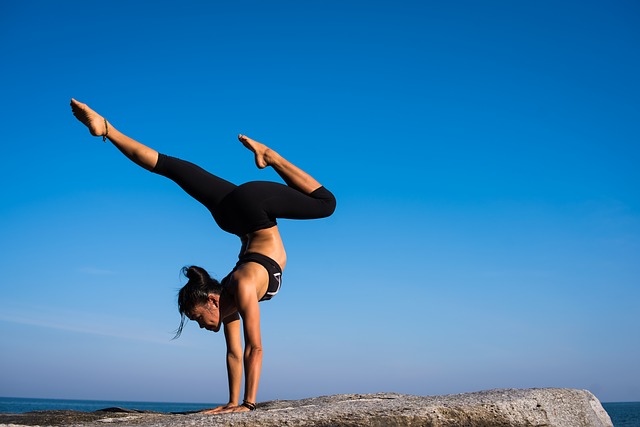Static stretching was probably introduced to you when you first started running. Hell, you probably stretched before you ever went running!

But it’s time to confront the conventional wisdom that runners need static stretching, especially before a run.
We should ask ourselves the hard questions:
- If the goal of stretching is “flexibility” then what does that really mean?
- Does stretching before running accomplish the goals of a proper warm-up?
- Is static stretching an effective injury prevention tool?
When I first started running in high school, 10 minutes of stretching before we started running was standard. We didn’t want to “be tight” and everyone knows (right?) that stretching helps you stay healthy.
This was the prevailing dogma for the first 5-6 years of my running career.
But soon, science started uncovering that what seems like common-sense may actually be harmful. Static stretching was no cure-all.
And that was reflected in my coaching: as the years passed and I became an upperclassmen at Connecticut College, we focused more on dynamic stretching and drills.
Soon, our coaches barely recommended stretching. Our training in college was then reaffirmed by one of my favorite books, Cardio or Weights? by Alex Hutchinson
The conclusion? Static stretching isn’t all that it’s cracked up to be.
Let’s take a look and see how we can use stretching strategically to improve our running.
Flexibility vs. Mobility
Is this static stretching?
There’s a big difference between flexibility and mobility.
Flexibility is the ability to achieve large ranges of motion in the joints. It’s passive.
Mobility is the ability to move through a normal range of motion with strength. It’s active.
If you can touch your toes, then you’re flexible.
But if you can sprint, move well over some basic obstacles, or run over hurdles then you have good mobility.
Static stretching is a very good way of improving your flexibility – with a consistent and thorough series of stretching exercises you’ll improve it over time.
But runners don’t need exceptional levels of flexibility. We just need to be able to move well as we sprint, charge up hills, and navigate the terrain of trails and obstacle course racing.
All that requires mobility rather than flexibility (more on how to improve mobility later).
Ultimately, we don’t need a lot of flexibility to improve our running. But that doesn’t mean we can’t engage in some static stretching.
Does Static Stretching Help You Warm Up Before a Run?
The most common times for stretching are either before running or stretching after you finish running. When you stretch before running, it’s to warm up.
But is stretching an effective warm-up routine?
Dr. Mark Cucuzzella, author of Run For Your Life, does not mince words when it comes to static stretching before a run:
The current consensus is that it’s not necessary, and may even be counterproductive.
The goal is to loosen, not stretch, and the best way to do this is to simply run at an easy, relaxed pace.
Add a few skips, lunges, and even a few short pickups… This is dynamic stretching.
That’s because static stretching does not accomplish the most basic goal of a warm-up routine: to warm up. It does not raise your heart rate, lubricate joints, metabolically prime muscles for work, increase elasticity in connective tissues, open capillaries, and raise your core body temperature.
In other words, it’s a failure as a warm-up.
Stretching our muscles before running may even be counterproductive. That’s because stretched muscles are less responsive and can’t hold as much tension. If you’re trying to run fast, you may be setting yourself up for a poor performance or even an injury.
The solution, as Dr. Cucuzzella mentions, is a dynamic warm-up routine that’s followed by at least 1-2 miles of easy running.
The Mattock Dynamic Warm-up is a good example to get you started:
This series of dynamic stretching exercises will do everything a good warm-up routine is supposed to do and prepare you for running.
Do it immediately before running to get all of the benefits. You’ll perform better, have a lower risk of injury, and feel better too!
Will Static Stretching Prevent Injuries?

Runners need not be yogis…
This is where my stance on stretching may surprise you: I consider it virtually worthless for injury prevention.
Dr. Cucuzzella is on board and notes that stretching is not usually a good treatment for injuries:
But when the fascia [connective tissues in your body] become overly stressed, it can become bunched into a knot…
It’s like yanking hard on the ends of a rope to untangle a knot: it only makes the knot harder and tighter. Too often, we do exactly this in the name of physical therapy and traditional stretching exercises.
Consider that most injuries happen within the normal range of motion. And that a very common running form problem is over-striding (i.e., too much range of motion!). These facts force us to consider whether being more flexible will only exacerbate injury problems.
The Centers for Disease Control and Prevention actually published a review of 361 studies in 2004 that tried to answer this question.
We ought to remember their conclusion:
“Stretching was not significantly associated with a reduction in total injuries… [and] use of stretching as a prevention tool against sports injury has been based on intuition and unsystematic observation rather than scientific evidence.”
If you’re stretching to stay healthy, you’re largely wasting your time.
But that doesn’t mean that static stretching has no place in your training program. In fact, when done properly it can boost feelings of well-being and relaxation – the ingredients necessary for optimal recovery.
Best Stretches for Runners
Ideally, runners will focus most of their time on a series of dynamic warm up exercises like the Mattock Routine above. Coupled with other activities that boost mobility and there’s little reason for static stretching.
Those “other activities” include:
- trail running
- sprinting
- drills
- foam rolling
- a variety of workouts
- strength training
These elements of training improve mobility without ever requiring you to stretch. And since they require active, functional movement, the flexibility you gain is more useful.
But static stretching can still have a place in any runners’ training program as long as a few caveats are met:
- It’s done at the right time…
- …at the right intensity…
- …without any big mistakes
I outlined some of my favorite static stretching examples in this new video:
The 3 mistakes to avoid when stretching are:
- Don’t stretch a cold muscle before exercise. Wait until you’re finished running!
- No “ballistic” stretching where you bounce in and out of a stretch
- Stretch for about a minute – not too long, but not too short
If you enjoy your static stretching routine, there’s no reason to stop. Just avoid these mistakes and you’re ready to stretch!
Loosen Up More Effectively
While static stretching can help you relax and feel better after a run, there’s no substitution for more effective mobility training.
Every week, you should be running fast, strength training, performing dynamic mobility drills, running off-road, and sitting less. Training this way will improve your mobility, competence, and injury resilience. No stretching needed.
But you can also get the effect of static stretching with even more recovery benefits by using a foam roller.
A foam roller – like this one – loosens musles, fascia, and connective tissues. It promotes healing blood flow and increases range of motion.
It’s my preferred way of stretching because it’s more effective.
Download our free Cheat Sheet to foam rolling for runners, featuring a photo guide for:
- Optimal Positions
- Common mistakes to avoid
- Best practices
- Ideal times for using a foam roller
Get it here and hang it up where you foam roll. Refer to it whenever you need that extra nudge to prioritize your recovery.
And hopefully, it will encourage you to foam roll more regularly and boost your mobility!